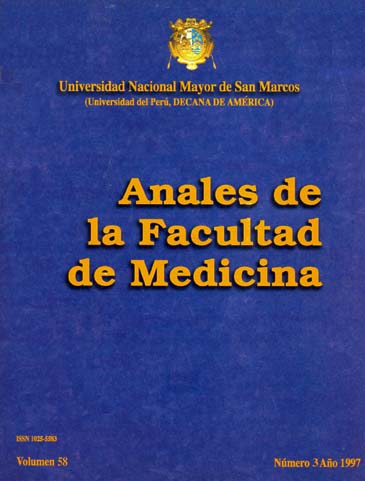Meaning and Application of the Criteria for Accreditation of Medical
DOI:
https://doi.org/10.15381/anales.v58i3.4686Abstract
The authors examined the operational purpose of 48 items that establish the criteria for accreditation for teaching , learning and assessment in a medical school , and determined to what extent these criteria are applied by schools and local evaluators in 59 programs evaluated by the Consensus Committee on Medical Education ( LCME ) in the period 1994-1996. In this study, "application" meant that the evidence was offered , although this does not necessarily meet the criteria tested . as sources of information were used databases of medical education and self-assessments prepared by the powers that were undergoing accreditation studies , and reports prepared by ad hoc teams of evaluators . For each of the 48 applicants for accreditation powers , often offering evidence of compliance with the criteria verified by the evaluators was determined. Moreover, as the dissent of the powers evaluated criteria , the authors compared the patterns of the reports prepared by the inspectors on assessed during the period 1984-1986 and 1994-1996 visited . In 1994-1996 , 42 schools sent 48 applications for accreditation in 90% or more of cases. The areas of focus were particularly low in relation to the definition and communication of educational objectives ( 47 % of schools provided evidence ) , faculty authority and control of academic programs at affiliated clinical ( 12%), and faculty commitment to the efficiency and knowledge of pedagogy, curriculum design and evaluation methods ( 8%). Inspection teams , however , noticed in their reports only 26 ( 55%) of the criteria during the same period. Among those sent less frequently , were the definition and communication of educational objectives by faculty ( constituting 59% of reports ), the assessment of students' ability to solve problems (51% ), the comparability of yea assessment educational experiences of students in the various branches of education ( 49 % ) , knowledge on the part of faculty pedagogy, curriculum development and student assessment (8 % ), the authority and control of the academic programs by teachers in affiliated clinics (7% ), and the knowledge of how to measure the performance of students by the administration and faculty ( 2%). In the last decade , the points most frequently cited by reviewers about the powers of dissent with the accreditation criteria have to do with regard to counseling and health services for students, funding resources , space and institutional infrastructure , aspects of the faculty and the freedom of action of the deanery and the positions of chairpersons of the departments. The next concern , by tried regarding various aspects of the educational program leading to the degree of MD (Medical Doctor) . Among the highlights of the educational program increased significantly during the last decade were those relating to the design, management and evaluation of the curriculum , the experiences of primary and ambulatory care , and policies of student progress and related issues . The authority paid much attention to most of the 48 standards , largely because they were hard pressed by the formation of the database of medical education and self-assessment protocols . In cases of minor application , the fault lay as much or more on ambiguities in the construction and the objective criteria in institutional leniency . The neglect of assessors for accreditation criteria is more worrying. In some cases, this can be attributed to uncertainties about the meaning of the requirements and the quantities that are required to be reported , or that the inspectors can be formed to reach a threshold of " substantial compliance " without achieving all the evidence. The authors argue that many of the criteria that were applied in some inspections are important for curriculum development and quality control . The MLEC need to consider whether more should be clarified definitions and highlighted instead of these criteria that had been left out, or if some of the requirements are outside as quality indicators . A planned inspection of the groups involved ? Educators , doctors, students , graduates and program managers residence , among others ? may help confirm the validity of the criteria and their importance to medical education.Downloads
Published
1997-09-15
Issue
Section
Artículo Especial
License
Copyright (c) 1997 Donald G. Kassebaum, Robert H. Eaglen, Ellen R Cutler

This work is licensed under a Creative Commons Attribution-NonCommercial-ShareAlike 4.0 International License.
Those authors who have publications with this magazine accept the following terms:
- Authors will retain their copyrights and guarantee the journal the right of first publication of their work, which will be simultaneously subject to Creative Commons Attribution License that allows third parties to share the work as long as its author and its first publication this magazine are indicated.
- Authors may adopt other non-exclusive licensing agreements for the distribution of the version of the published work (eg, deposit it in an institutional electronic file or publish it in a monographic volume) provided that the initial publication in this magazine is indicated.
- Authors are allowed and recommended to disseminate their work over the Internet (eg: in institutional telematic archives or on their website) before and during the submission process, which It can produce interesting exchanges and increase quotes from the published work. (See El efecto del acceso abierto ).
How to Cite
1.
Kassebaum DG, Eaglen RH, Cutler ER. Meaning and Application of the Criteria for Accreditation of Medical. An Fac med [Internet]. 1997 Sep. 15 [cited 2024 Jul. 5];58(3):210-21. Available from: https://revistasinvestigacion.unmsm.edu.pe/index.php/anales/article/view/4686















